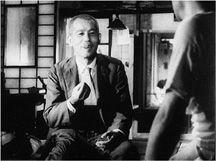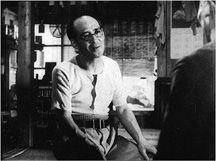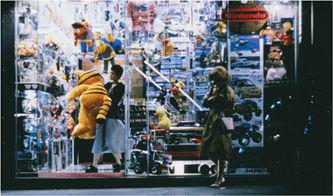B0041VYHGW EBOK (172 page)
Authors: David Bordwell,Kristin Thompson

In these ways, Ozu draws our attention away from the strictly causal functions of space and makes space important in its own right. He does the same with the flat space of the screen. (Examples of graphic matches from Ozu films are found in
6.128
–
6.131
.) The stylistic device is characteristic of Ozu, who seldom uses the graphic match for any narrative purpose. In
Tokyo Story,
a conversation situation leads to a shot/reverse-shot pattern but again with cuts 180° across the axis of action. The two men speaking are framed so that each looks off right. (In Hollywood, upholders of the continuity system would claim that this implies that both are looking off toward the same thing.) Because they are positioned similarly in the frame, the result is a strong graphic match from one shot to another
(
11.60
,
11.61
).
In this respect, Ozu’s style owes something to abstract form (see
Chapter 10
,
pp. 368
–374). It is as if he sought to make a narrative film that would still make graphic similarities as evident as they are in an abstract film like
Ballet mécanique.

11.60 A graphic match created by cutting across the line from the grandfather …

11.61 … to his friend as they converse.
The use of space and time in
Tokyo Story
is not willfully obscure, nor does it have a symbolic function in the narrative. Rather, it suggests a different relationship among setting, duration, and story action than exists in the classical film. Space and time no longer simply function unobtrusively to create a clear narrative line. Ozu brings them forward and makes them into prominent aesthetic elements in their own right. A large part of the film’s appeal lies in its strict but playful treatment of figures, settings, and movement. Ozu does not eliminate narrative, but he opens it out.
Tokyo Story
and his other films allow other stylistic devices to exist independently alongside narrative. The result is that the viewer is invited to participate in his films in a new way.
1994. Jet Tone, Hong Kong. Directed by Wong Kar-wai. Script by Wong Kar-wai. Photographed by Andrew Lau Wai-keung and Christopher Doyle. With Brigitte Lin Ching-hsia, Takeshi Kaneshiro, Tony Leung Chiu-wai, Faye Wong Jingwen.
Contemporary Hollywood filmmakers have sometimes explored what has been called the
web-of-life plot.
Instead of two primary lines of action, as in
His Girl Friday
or
North by Northwest,
some recent films weave together a large number of plotlines, often involving many characters. Precedents for this can be found in
Grand Hotel
(1932) and
Nashville
(1976), but in the 1990s, such films as
Short Cuts, Pulp Fiction, Magnolia, Traffic,
and
Love Actually
made this sort of plotting more common. The plotlines may at first seem completely isolated from one another, but usually they converge, revealing unexpected causal connections. In
Magnolia,
the characters are linked through television (all are connected in one way or another to the television producer Earl Partridge) and through chance encounters (as when the police patrolman meets Partridge’s unhappy daughter).
The audience expects a web-of-life plot to reveal unforeseen relations among the disparate characters. Seen from this standpoint,
Chungking Express
constitutes an intriguing experiment in nonclassical form. It is broken into two distinct stories, each organized around a different batch of characters, and the two stories aren’t crosscut but simply set side by side. One question viewers commonly ask is, What has director Wong Kar-wai accomplished by putting these two stories in the same film?
In the first tale, Officer 223 (for ease of recall, we’ll call him Officer 1) has just broken up with his girlfriend and lives in hope that she’ll take him back before May 1, his 25th birthday. Wandering the city at night, he runs into a mysterious woman in dark glasses and a blonde wig. He doesn’t know that she runs a drug-smuggling outfit. She has hired some Indian down-and-outs to swallow bags of cocaine and fly out of the country, but they have defected with the drugs. She must recover the shipment or face the wrath of her boss, a Westerner who runs a bar. Officer 1 meets her in a bar and takes her to a cheap hotel, where she sleeps off her drinking and he eats snacks. In the morning, he leaves her; she posts an affectionate message on his pager before returning to the bar and shooting her boss dead.
“[Financiers in Asia] always ask, ‘Is it a cop story or a gangster story?’ So you have to choose. One or the other …. So with
Chungking Express,
I said it is a cop
and
a gangster story. We have gangsters, and we have cops. But it is not a gangster/cop story. It’s just about their lives, and that’s it.”— Wong Kar-wai, director
The second and longer tale introduces Officer 633 (Officer 2), who is happy with his girlfriend, a flight attendant. But one day she leaves him. He is still trying to get over their affair when Faye, a counterwoman at his favorite fast-food spot, the Midnight Express, takes an interest in him. The flight attendant leaves Officer 2’s keys at the Midnight Express for him to pick up, and Faye uses them to explore his apartment while he’s out. She tidies it up and redecorates it to try to cheer him up, leaving fresh soap and towels and filling his aquarium with fish. After catching her in the apartment, he realizes she’s flirting with him, so he packs up his girlfriend’s things and sets off to meet Faye for a date. But she stands him up, leaving for California—the place she had always hoped to visit. A year later, Officer 2 has bought the Midnight Express and is renovating it when she returns. Now
she’s
a flight attendant, and there is a hint that their romance might finally begin.
What links the two parts? Both employ handheld camera work, moody music, and voice-over commentaries drifting in and out. But a common style is normally not enough to justify putting two stories together. Since both protagonists are policemen, we might expect them to encounter one another, but they never do; the first is a plainclothes detective, while the second pounds a beat. Nor does the mysterious blonde’s drug smuggling ever impinge on the cops’ activities; Officer 1 is ignorant of her racket, and Officer 2 doesn’t, for instance, investigate the murder of the bar owner, as he might in another kind of plot. The two strands do share one locale: both Officer 1 and Officer 2 hang out at the Midnight Express. Nonetheless, this doesn’t connect the parts causally, since Officer 1 meets Faye only once, and he never becomes a rival for her affections. As if to tease sharp-eyed repeat viewers, Wong inserts into the first part a brief, distant shot of each main character who will appear in the second part—Officer 2, the flight attendant, and Faye
(
11.62
).
But they are unknown to us on the initial viewing, and they aren’t presented as shaping the story action in the first part.

11.62 In
Chungking Express,
while the mysterious blonde woman lounges outside a shop, Faye (whom we do not meet until
part two
) leaves with a stuffed toy (perhaps destined for Officer 2’s apartment).
It is as if Wong has juxtaposed the two stories in such a way to demand that we find our own connections between them. By analyzing narrative form and style, we can bring to light some intriguing similarities and differences, which in turn point to a set of themes that unify the film.
In broad narrative terms, the two parts stand in sharp contrast. The first takes place on the Kowloon peninsula of Hong Kong, in and around Chungking Mansions, a decaying block of cheap guest quarters, shops, and Indian restaurants. (The Cantonese title of the film translates as “Chungking Jungle,” and it may tease the local viewer into believing that eventually the second story will return to this neighborhood.) The second part takes place on Hong Kong Island, across the bay from Kowloon, in the vicinity of the Midnight Express. The Kowloon of
part one
teems with crime; Officer 1 chases suspects down at gunpoint, while the blonde works for a drug cartel.
Part two
presents a far less threatening world, where romance can blossom and the cop on the beat drops in for snacks. The English-language title of the film fuses the basic locales of each part, balancing Chungking Mansions with Midnight Express in a single phrase.
The two parts offer very different time schemes as well. The first part takes place over a short span, about four days, and the action labors under deadlines. Officer 1 has given May, his ex-girlfriend, the month of April to come back to him. The blonde’s deadline for the smuggling operation has been set by her boss, and she meets it by shooting him and flying out of Hong Kong on May 1. The second part has a much looser time frame and no strong deadlines. Over a period of weeks, Officer 2’s girlfriend leaves him, Faye invades his apartment, he transfers his beat, and after a series of casual encounters they finally make a date … that Faye ignores, suddenly departing. The action concludes a year later when she flies back to Hong Kong.
Yet within these broad contrasts, some echoes do emerge. Each man is coming out of a love affair; each meets a woman by chance; quickly or slowly, each becomes attached to her; the woman abruptly departs. The characters’ goals are also revealing. Officer 1 seeks a new woman to love, and although Officer 2 is content to drift, Faye seems to try to ease his broken heart. These goals are presented more vaguely and pursued more erratically than in a Hollywood film, but the parallels suggest that
Chungking Express
revolves around romance. The more closely we look at cause–effect chains, motifs, and visual style, the more evidence we find that the film is comparing ways in which people try to find love.
The two policemen’s romantic problems shape their attitudes toward time. Neither man is sensitive to the fact that love affairs must adjust to change. In
part one
, ruled by fast pace and deadlines, Officer 1 has been pining for a month and now wants to find a new girlfriend immediately. Officer 2, suddenly dumped by his girlfriend, can’t summon up the energy to restart his love life. Both men fill their stretches of waiting with cycles of repetitive behavior. Officer 1 badgers May’s family and then calls old girlfriends to ask for a date. Officer 2 repeatedly visits the Midnight Express, first to pick up snacks for himself and his girlfriend, then simply to brood; after he switches his shift, he frequents a food stall on another street. Although one wants a sudden adventure and the other falls back on routine, both are caught in spirals of inactivity. Wong emphasizes this through parallel images of each man moping in his apartment
(
11.63
,
11.64
).
